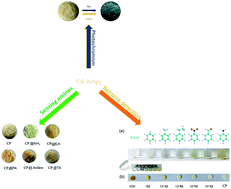A novel photochromic coordination polymer based on a robust viologen ligand exhibiting multiple detection properties in the solid state†
Abstract
A new photochromic and porous Cd(II) coordination polymer (CP) has been synthesized by using a robust viologen ligand, named 1-(3-carboxybenzyl)-4,4′-bipyridinium chloride (m-Hbcbpy·Cl) and CdCl2·2H2O. This CP (Cd-bcbpy) shows a fast response and reversible photochromism through the progress of ET due to the formation of viologen radicals. Cd-bcbpy shows a sharp response to blue rays and selectively detects organic amine molecules, which are electron rich, in the solid state due to the electron-deficient properties of m-Hbcbpy·Cl. The detection of organic amine and benzene molecules has been confirmed by the visual color changing phenomenon and luminescence quenching experiment. Cd-bcbpy can detect aniline in very low concentrations (10−4 M). In addition, the structure of Cd-bcbpy maintains stability in aqueous solutions of hydrochloric acid with the pH ranging from 1 to 7. The photo-controlled luminescence properties of this CP, during the coloration–decoloration process, have been studied.



 Please wait while we load your content...
Please wait while we load your content...